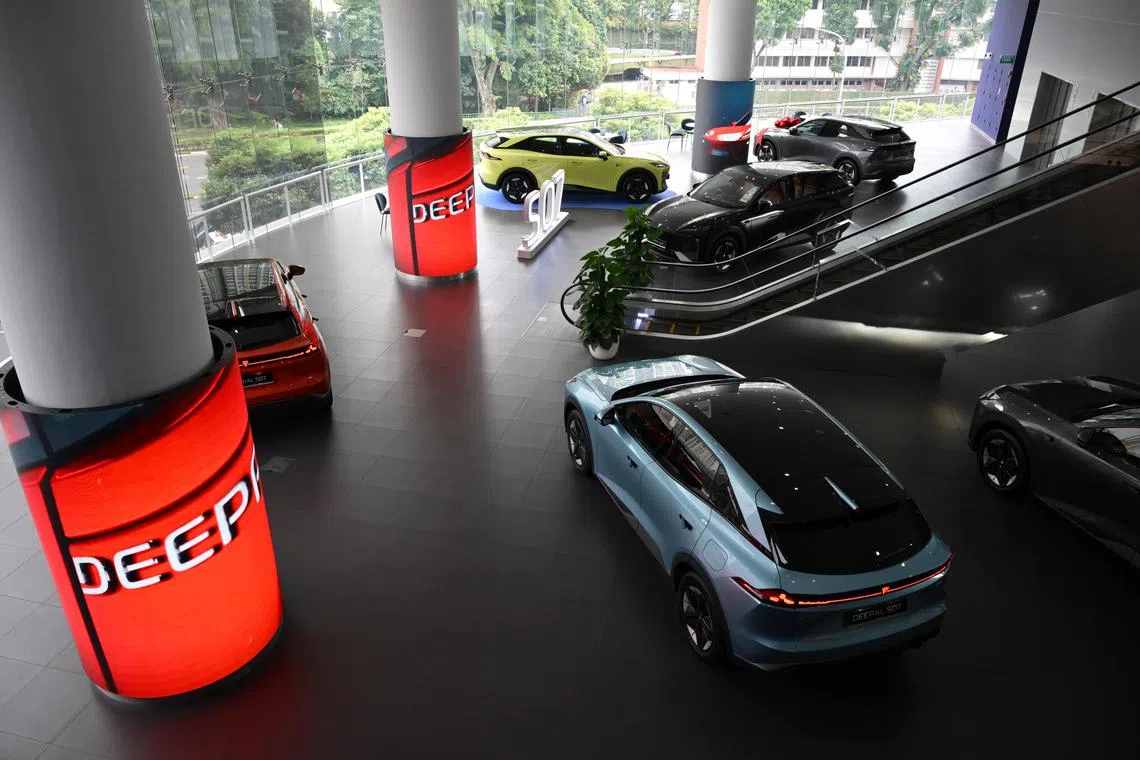News analysis
What’s keeping COE prices up, and where premiums are headed
Sign up now: Get ST's newsletters delivered to your inbox

The entry of new Chinese car brands like Deepal has intensified competition, contributing to greater demand for COEs.
ST PHOTO: NG SOR LUAN
Follow topic:
SINGAPORE – One year ago, a new Toyota Corolla Altis cost $161,888.
The price of this model has risen by $14,000 to $175,888 after the latest certificate of entitlement (COE) tender on Aug 20, driven largely by the higher COE premium in 2025.
A Category A COE – meant for smaller, less powerful electric vehicles (EVs) or cars like the Altis – costs $104,524 after the Aug 20 tender, nearing the record of $106,000 set in October 2023.
The price of Category B COEs, used to register larger cars and EVs, reached $124,400, the highest since December 2023.
This is despite a 29.4 per cent rise in the supply of Category A COEs and a 19 per cent increase for Category B COEs from a year ago.
Barring drastic policy changes, COE premiums are expected to stay high for the rest of 2025 on the back of strong demand, intensifying competition among car dealers, the increasing momentum of EV adoption,
How premiums will develop in 2026 and beyond remains to be seen, as the supply of COEs is projected to continue increasing.
Why COE prices look set to remain high in 2025
There has been an influx of new Chinese EV brands
The newcomers are up against existing dealerships, which typically amp up their efforts in the third quarter of the year and race to secure COEs to hit their annual sales targets.
Existing incentive schemes for EVs contribute to higher COE premiums, said automotive industry consultant Say Kwee Neng.
The incentives lower the upfront purchasing cost of EVs, and allow dealers to place higher bids for COEs and still price their electric models more attractively than non-electric ones, without compromising their profits.
An electric car can get up to $40,000 in rebates off the vehicle tax when it is registered, via the EV Early Adoption Incentive scheme and the Vehicular Emissions Scheme.
Both schemes are due to expire on Dec 31.

While motor dealers generally expect the Government to continue providing some form of incentives to encourage consumers to pick EVs and cleaner-emission vehicles, no one knows what form that will take in 2026 and beyond.
On the showroom floor, salespeople are using this uncertainty to nudge hesitant customers into making their purchases now to avoid missing out on the rebates.
Ms Corinne Chua, managing director of Volvo at Wearnes Automotive, is hoping there will not be a repeat of what happened in 2023, when COE premiums spiked after the Land Transport Authority announced in September that year that incentives would be reduced from Jan 1, 2024.
The rush to beat the deadline back then added extra pressure at a time when the COE supply was already quite limited.
Industry veteran Neo Nam Heng, chairman of Prime Group and honorary adviser to the Automobile Importer and Exporter Association, said the price advantage that EVs enjoy because of incentives is a big driver behind the accelerating EV adoption rate as electric cars can be priced below their comparable petrol-powered rivals.
One example is the BYD Atto 2, an electric sport utility vehicle. After rebates, it is priced at $159,888 with COE. In contrast, a similar-sized model like the Honda HR-V, which does not qualify for any tax incentives, costs $170,999 with COE.
In the first seven months of 2025, EVs made up 41.6 per cent of new car registrations with 11,887 units.
Based on the current registration trends, it is likely that new EV registrations for 2025 will exceed the 14,448 units (33.6 per cent of new car registrations) in 2024.
Another factor keeping premiums elevated is higher demand from owners looking to replace their existing cars, which are reaching the end of the 10-year COE lifespan.
There were 57,589 new cars registered in 2015, which is nearly double the 28,932 units in 2014. Annual new car registrations continued to increase significantly in the following years, peaking at 91,922 cars in 2017, before falling to 80,281 units in 2018.
In other words, the number of cars nearing the end of their COE is higher in 2025 than in previous years. A COE is returned to the pool for bidding when vehicles are deregistered.
However, owners typically replace their ageing cars before deregistering them. This means that before the COE supply hits its peak, demand for the certificates is already surging.
This rise in demand will then prevent COE premiums from coming down.
The outlook for 2026 and beyond
The quantum of incentives to encourage EV adoption in 2026 – if there are any at all – will play a significant role in determining demand for COEs.
If the incentives are withdrawn or scaled back, it could lead to a last-minute rush for EVs before the deadline and possibly a short-term cooling of demand after the current schemes expire at the end of 2025.
However, if the level of support is sustained at current levels, the clarity provided by such a move may calm demand somewhat as some buyers will decide to wait instead of committing to a new car in 2025.
The competition for EV buyers is also set to become more intense in 2026, with more new Chinese EV brands expected to enter Singapore and join an already crowded market. These include brands like IM, Hongqi and Nio, represented by established motor dealer groups that have the muscle and experience to put up a good fight.
This is even as relative newcomer brands like Aion, Deepal and Xpeng are gaining a foothold, and BYD seems to be further extending its lead as the top-selling car brand in Singapore.
Mr Ron Lim, head of sales and marketing at Nissan agent Tan Chong Motor, reckons that some brands may drop out down the road, but before that happens, competition in the market will be fierce as both new and established players fight for survival and jostle for market share.
On the supply front, there will be more COEs available for bidding in the coming years as more cars are deregistered.
This may eventually lead to lower COE premiums, but the magnitude of the drop, and whether it can be sustained, will hinge on how quickly demand cools.
Those who can afford to wait may consider delaying purchases until then.


